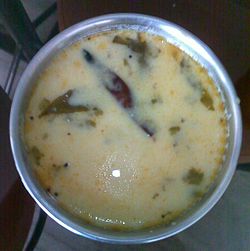Pakistani soups and stews

- Abgooshth – lamb and lentil soup [2]
- Chakna – tripe stew with chunks of liver and kidneys
- Shorva – Chorba (called shorba in Pakistan) [3] is one of various kinds of soup or stew found in national cuisines across the Balkans, Eastern Europe, Central Asia, and the Middle East
- Haleem – prepared with wheat, barley, chicken, goat or buffalo meat, [4] lentils and spices
- Kadhi – a spicy dish whose thick gravy is based on chickpea flour, [5] and contains vegetable fritters called pakoras, to which sour yogurt is added. In Pakistan, it is usually served with boiled rice and naan. Fish karhi and egg karhi are also popular.
- Khichra – a variation of the dish Haleem, popular with Muslims of South Asia. It is prepared with lentils, rice, meat and spices. [6]
- Nihari – regarded as a national dish of Pakistan
- Siri paya − a Pakistani delicacy, its main ingredients are the hoof (trotters) and head of a lamb or goat, cooked with cilantro and ginger. [7]


